Page 1 of 1
French Pyrenees September
Posted: Thu Sep 15, 2016 5:40 pm
by dragnil
Hello all,
Another year passes and I am here again to ask for help with identifying butterflies seen in the mountains in a very hot period from late August to mid September.
In the first picture
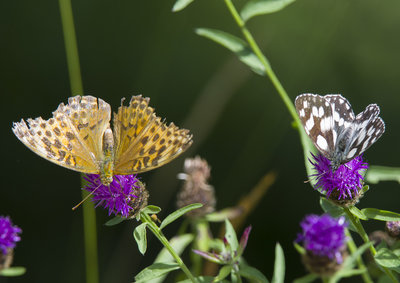
- No 1
am I right in saying Queen of Spain Fritillary for the one on the left? Even if I am right there it's no help with the small B&W job on the right.
Second shot
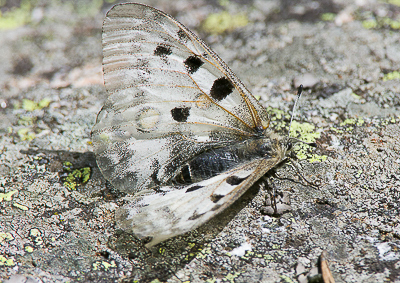
- No 2
is a mystery to me.
Number 3 almost had me coming down off the fence and saying Scotch Argus
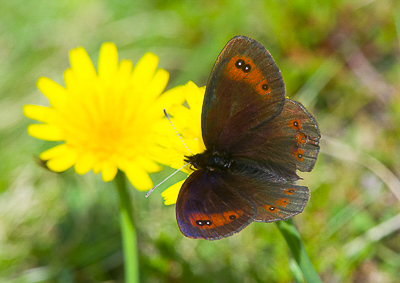
- No 3
but the Collins guide suggests it may be out of its range - any suggestions please?
Nos 4 and 5 are, I think, the same species but, again, I'm no expert so I'd be grateful for the benefit of the forum's expertise.
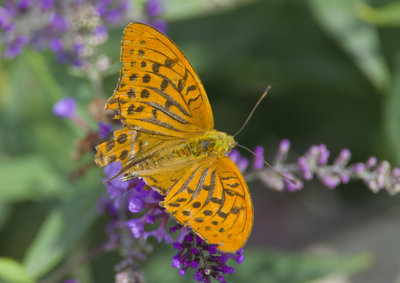
- No 4
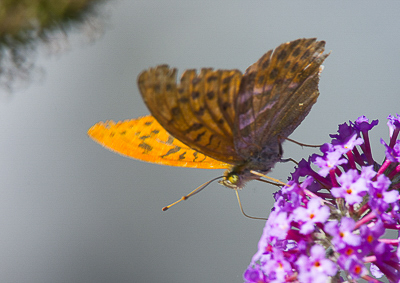
- No 5
As in previous years, I'm grateful for the help readily given in this forum and would ask for pointers to the features that make it what it is, so I can learn, even if that process is a slow one in this aged birdwatcher. Thanks to all for looking.
David
Re: French Pyrenees September
Posted: Fri Sep 16, 2016 9:09 am
by LancsRover
Hi David, no.4 & 5 are Silver-washed fritillaries, males and I think no.1 also, the black & white in no.1.is a marbled white, that's as far as I go with my knowledge

Russ
Re: French Pyrenees September
Posted: Fri Sep 16, 2016 9:41 am
by dragnil
Thanks, Russ,
It's dead easy when someone tells you which page to look at! And thanks for confirming that 4 & 5 are the same bf.
David
Re: French Pyrenees September
Posted: Fri Sep 16, 2016 12:03 pm
by dilettante
No 2 is an Apollo (Parnassius Apollo), I'd say
Re: French Pyrenees September
Posted: Fri Sep 16, 2016 3:28 pm
by dragnil
Thanks, dilettante, at first I thought, Where are the red "roundels"?
I can see, now that they are hidden by the front wing. We're getting there, how about "my" Scotch Argus?
Re: French Pyrenees September
Posted: Sat Sep 17, 2016 3:39 pm
by dragnil
After more Collins and Google I've found ringlets! Crikey, how do you separate them, it seems worse than some warbler species in my world of birds. As far as I can see, from my very limited experience and less knowledge, it might be an Autumn or a Gavarnie but I really need an expert to help here, because I really don't have a clue! It was in the next valley to the west of Gavarnie, but how limited is the range? Any further help gratefully accepted.
David
Re: French Pyrenees September
Posted: Sat Sep 17, 2016 4:06 pm
by Chris Jackson
Hello David,
Well done, yes it is a Ringlet. This genus is called Erebia.
There are 28 Erebia sp. in France. Some are restricted solely to the Alps, another to the Cévennes, and others to the Pyrenees.
So by elimination we can reduce the possibilities down to 13 species. Others can be eliminated by altitude, flight period and distribution along the Pyrenees.
Autumn ringlet should be
very much further east of Gavarnie, so you can eliminate that one.
Can you give us an altitude ?
I see the photo was taken on the 2nd September -> a bit of flexibility however must be given to the flight periods stated in the different reference books, for butterflies in general these periods can vary by a couple of weeks or more according to altitude and latitude.
Chris
NB : An image in one of my books points towards
Erebia pronoe female form
glottis, and the flight period is good.
Erebia meolans is a possibility.
Erebia cassioides ?

..... nope ! What you need is an expert.

Re: French Pyrenees September
Posted: Sun Sep 18, 2016 8:15 am
by dragnil
Hello Chris,
Thanks for all that, at least I found the right genus! The best estimate of altitude from my map would be 1600 metres +- 100 - does that narrow it down further?
ATB
David
Re: French Pyrenees September
Posted: Sun Sep 18, 2016 11:29 am
by Padfield
With Erebia it really helps to see the upperside and the underside - and sometimes, without both, you have to accept you will never know for certain what you have seen.
In my opinion, this one is most likely pronoe. A glance at the underside would confirm - the violet hints on the hindwing and apex of the forewing are unique to this species. Pronoe is one of the latest ringlets, still being fresh in late August and Sepember. Chris suggested meolans as a possibility. Nearly always, the ocelli on the hindwing of this species are distinctly at the outer edge of the red, not central. The only other theoretical possibility, I would say, is oeme. This is typically an earlier species, especially at lower altitudes, and my gut feeling (reinforced by the antennal tip colour) is against this.
Guy
Re: French Pyrenees September
Posted: Sun Sep 18, 2016 3:09 pm
by dragnil
Thanks Guy. If it's not easy for your chaps then I don't feel quite so bad at not being able to pin it down from the book.
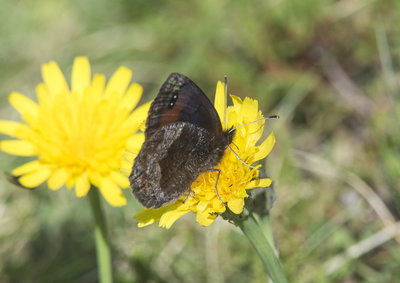
- Underside
Does this help?
David
Re: French Pyrenees September
Posted: Sun Sep 18, 2016 3:32 pm
by Chris Jackson
Hi David and Guy,
That light coloured band on the underside and lack of under hindwing ocelli would seem to rule out meolans and oeme and lean in favour of pronoe, as Guy suggests.
Chris
Re: French Pyrenees September
Posted: Sun Sep 18, 2016 4:15 pm
by dragnil
Thanks to all for the help, I'm very grateful. This is the only place in the world that draws us back year after year and although we go primarily for the birds you can't ignore nature's other beauties. Next year will be our twentieth so we're going in late May, as soon as the snow melts, as well as our customary autumn visit. It's pointless taking photographs if you can't identify what's in the image and this forum has been my first port of call for help over the years. It is certainly the most helpful and encouraging forum I have visited - thanks to you all.
Re: French Pyrenees September
Posted: Sun Sep 18, 2016 5:36 pm
by Padfield
Ah - with the underside, 100% pronoe. Nothing else looks like that. This is a very variable species from the upperside but unmistakable from below.
Guy